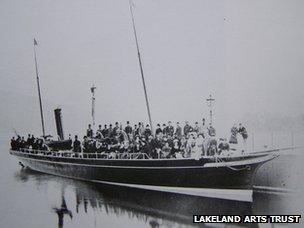Windermere Steamboat Museum to restore historic boats
- Published

Steamboats on Windermere were once all the rage among the wealthy
"The haves and the have-yachts" has become a popular catchphrase to refer to the chasm between the global super-rich and the well off.
But the "have-yachts" were a familiar sight around Lake Windermere more than 100 years ago.
Around the turn of the 20th Century, luxury steamboats were all the rage among the area's wealthy.
But the trend was not to last.
Thankfully the heritage left by Windermere's golden age of steam has not been lost.
The Windermere Steamboat Museum, external, which closed to the public in 2006, is restoring its collection of historic vessels and redeveloping the site, which is set to reopen in 2015.
Wealthy industrialists began commissioning luxury yachts on the lake around the middle of the 19th Century.
The fashion really took off in the 1890s, when increasing numbers of Victorian bourgeoisie established weekend retreats around the area, before dropping off during World War I.
Extravagant

TSSY Esperance: steel magnate Henry Schneider used this luxury yacht to commute to work
"Everything changed. There weren't enough people to operate the boats and a lot of them were broken up," said museum curator Margaret Reid.
After the war, newer technology took over from outmoded steam.
Among the museum's 40 boats, which are currently in dry storage while work goes on, are some of the most lavish vessels of their time.
The collection includes the TSSY Esperance (1869), built for steel magnate Henry Schneider, who used his yacht to commute to work.
It is said his butler would bring his breakfast aboard on a silver tray, which he would eat on his journey to Lakeland.
There he would catch the train and travel in his own private carriage onto Barrow where his steelworks lay.
The boat was also the inspiration for Captain Flint's houseboat in Arthur Ransome's Swallows and Amazons.

The lavish SS Britannia was one of many boats broken up after WWI
Other significant vessels include the SL Dolly (1850), which is believed to be one of the oldest mechanically-powered boats in the world.
The Dolly was one of several boats raised from the bottom of the lake when the collection was put together.
Meanwhile the SS Britannia (1879), described by Ms Reid as "the most luxurious vessel ever on the lake", is no longer, having been broken up in 1919.
But the museum still has the extravagant monogrammed tableware from the opulent steamer.
'Difficult decisions'
The collection was assembled by local builder and boating enthusiast George Pattinson, who was determined to preserve the vessels for posterity.
He amassed most of the current collection for the Windermere Nautical Trust, using boats he owned himself, as well as donations and loans from other enthusiasts.
The vessels went on display when the museum opened in 1977.

SL Dolly, which was rescued from the lakebed, is the oldest mechanically powered boat in the world
Pattinson's vision was to have as many boats as possible afloat on the lake for demonstrations, with only the more delicate in dry storage.
As a result people could see the vessels in action, but conservation was more costly and difficult, leading to the expensive restoration now in progress.
Ms Reid said they had "difficult decisions" to make about which boats would be in operation, once the museum reopened.
"We have to be really careful, because we have to worry about maintenance and the historic fabric of the boats," she said.
The Lakeland Arts Trust, external, which took over the museum in 2007, has been able to raise most of the funds for the project and last month applied for a grant from the Lottery Heritage Fund.
A drop-in consultation on the plans for the new site will take place on Monday 15 April, with a large-scale model of the proposed redevelopment.
The trust said the total value of the project was £13.4m.
- Published19 October 2012
- Published9 December 2011
- Published30 August 2011